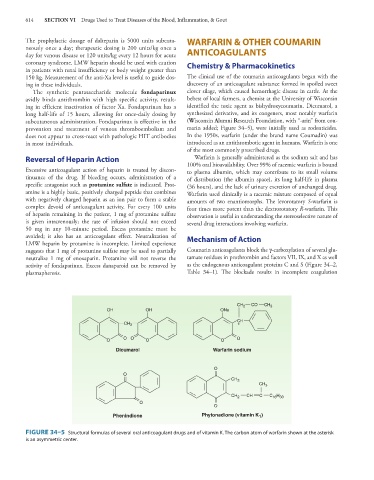Page 628 - Basic _ Clinical Pharmacology ( PDFDrive )
P. 628
614 SECTION VI Drugs Used to Treat Diseases of the Blood, Inflammation, & Gout
The prophylactic dosage of dalteparin is 5000 units subcuta- WARFARIN & OTHER COUMARIN
neously once a day; therapeutic dosing is 200 units/kg once a
day for venous disease or 120 units/kg every 12 hours for acute ANTICOAGULANTS
coronary syndrome. LMW heparin should be used with caution Chemistry & Pharmacokinetics
in patients with renal insufficiency or body weight greater than
150 kg. Measurement of the anti-Xa level is useful to guide dos- The clinical use of the coumarin anticoagulants began with the
ing in these individuals. discovery of an anticoagulant substance formed in spoiled sweet
The synthetic pentasaccharide molecule fondaparinux clover silage, which caused hemorrhagic disease in cattle. At the
avidly binds antithrombin with high specific activity, result- behest of local farmers, a chemist at the University of Wisconsin
ing in efficient inactivation of factor Xa. Fondaparinux has a identified the toxic agent as bishydroxycoumarin. Dicumarol, a
long half-life of 15 hours, allowing for once-daily dosing by synthesized derivative, and its congeners, most notably warfarin
subcutaneous administration. Fondaparinux is effective in the (Wisconsin Alumni Research Foundation, with “-arin” from cou-
prevention and treatment of venous thromboembolism and marin added; Figure 34–5), were initially used as rodenticides.
does not appear to cross-react with pathologic HIT antibodies In the 1950s, warfarin (under the brand name Coumadin) was
in most individuals. introduced as an antithrombotic agent in humans. Warfarin is one
of the most commonly prescribed drugs.
Reversal of Heparin Action Warfarin is generally administered as the sodium salt and has
100% oral bioavailability. Over 99% of racemic warfarin is bound
Excessive anticoagulant action of heparin is treated by discon- to plasma albumin, which may contribute to its small volume
tinuance of the drug. If bleeding occurs, administration of a of distribution (the albumin space), its long half-life in plasma
specific antagonist such as protamine sulfate is indicated. Prot- (36 hours), and the lack of urinary excretion of unchanged drug.
amine is a highly basic, positively charged peptide that combines Warfarin used clinically is a racemic mixture composed of equal
with negatively charged heparin as an ion pair to form a stable amounts of two enantiomorphs. The levorotatory S-warfarin is
complex devoid of anticoagulant activity. For every 100 units four times more potent than the dextrorotatory R-warfarin. This
of heparin remaining in the patient, 1 mg of protamine sulfate observation is useful in understanding the stereoselective nature of
is given intravenously; the rate of infusion should not exceed several drug interactions involving warfarin.
50 mg in any 10-minute period. Excess protamine must be
avoided; it also has an anticoagulant effect. Neutralization of Mechanism of Action
LMW heparin by protamine is incomplete. Limited experience
suggests that 1 mg of protamine sulfate may be used to partially Coumarin anticoagulants block the γ-carboxylation of several glu-
neutralize 1 mg of enoxaparin. Protamine will not reverse the tamate residues in prothrombin and factors VII, IX, and X as well
activity of fondaparinux. Excess danaparoid can be removed by as the endogenous anticoagulant proteins C and S (Figure 34–2,
plasmapheresis. Table 34–1). The blockade results in incomplete coagulation
CH 2 CO CH 3
OH OH ONa
CH
CH 2 *
O O O O O O
Dicumarol Warfarin sodium
O
O
CH 3
CH 3
CH 2 CH C C H
16 33
O
O
Phenindione Phytonadione (vitamin K )
1
FIGURE 34–5 Structural formulas of several oral anticoagulant drugs and of vitamin K. The carbon atom of warfarin shown at the asterisk
is an asymmetric center.

